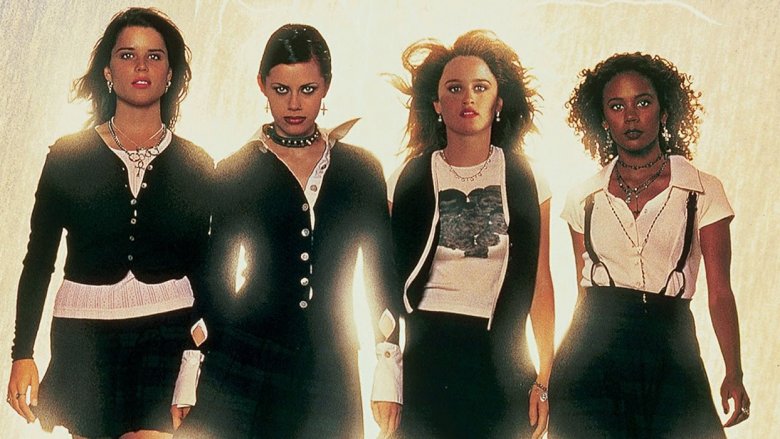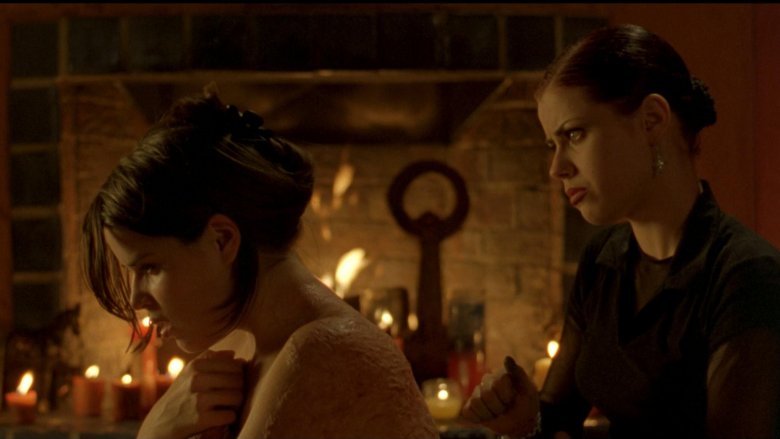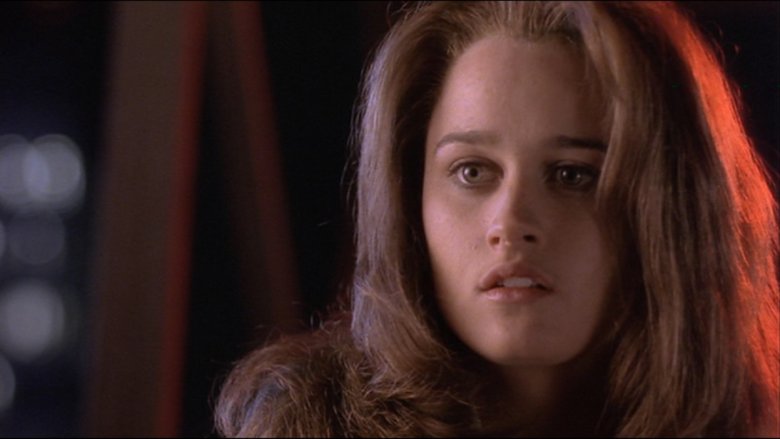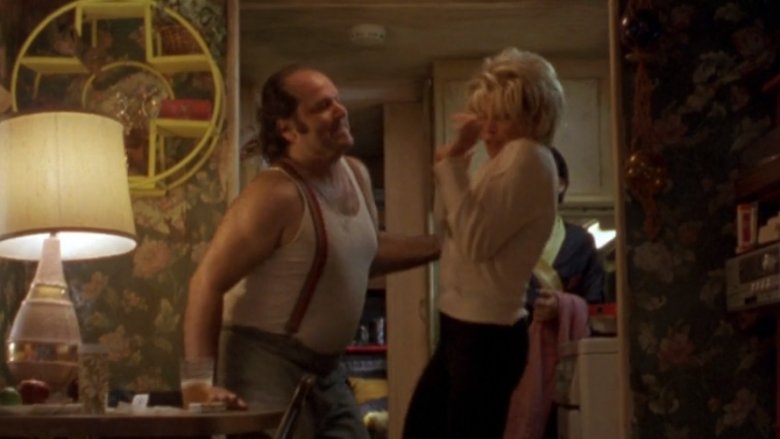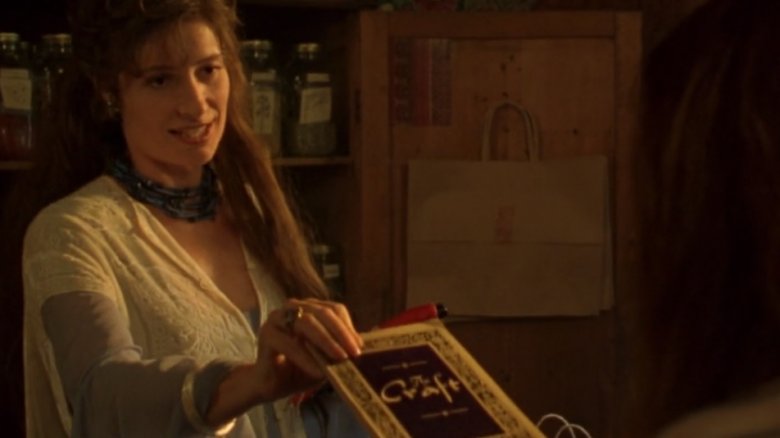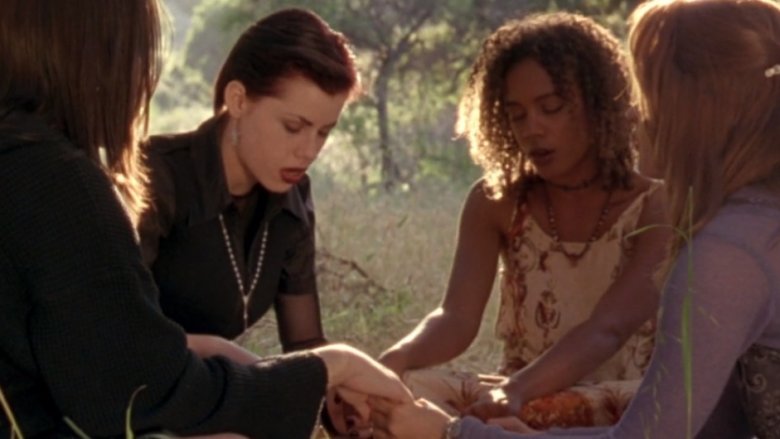Things About The Craft You Only Notice As An Adult
You can't talk about iconic '90s movies without talking about the year 1996. It was a magical year for movies, mostly because of the release of The Craft, which quickly became canon for millions of teenage girls, myself included. It was a world away from its contemporaries, like Sabrina the Teenage Witch and Practical Magic, due to its real-world themes, iconic '90s fashion, and subversion of female gender roles. Plus the fight scenes were epic.
And even though it tackled some pretty heavy issues at the time — it was not exactly light viewing — you still might have missed some of the deeper observations. Here are some of the things you only notice about The Craft when you're an adult.
The men in the movie perpetuate rape culture
It was quite clear back in '96 that the men in The Craft are pretty terrible across the board. Between abusive step-fathers and cruel classmates, you can't get much lower than that. But as an adult you notice specifically that these men all perpetuate rape culture.
Mitt, a fairly minor character, does this by calling Sarah a "snail trail" about eight minutes into the movie. But he's not as bad as Chris, who does a litany of rapey things, like calling Nancy a slut, then stating that he "doesn't know from experience or anything." He also tries to get Sarah to go to his house when no one's there, obviously for sex. When Sarah refuses, he proceeds to lie to everyone in school, saying she's the lousiest lay he's ever had.
When she confronts him, he acts like he's the one turning her down, saying to her, "I don't wanna go out with you again. Please stop begging, it's pathetic." And later, when he's apologizing for his behavior, he tells Sarah, "When you're a guy, people expect things" — things being sex, of course, like it's totally okay for men to do that. And then he legit tries to rape Sarah around the hour mark, showing just how steeped in rape culture thinking he is.
It has commentary on racism
Rochelle is the target of some pretty horrific racist bullying at the hands of Laura, a blonde haired, blue-eyed classmate who seems bent on making Rochelle's life hell. First, Laura yells "shark" to distract Rochelle from diving, which could have led to her getting injured. Then, later in the locker room, Laura picks up her hair brush and says, "Oh god, look. There is a pubic hair in my brush. Oh no, wait. That's just one of Rochelle's little nappy hairs."
Rochelle is understandably hurt, and asks Laura why she does this. She responds, "Because I don't like negroids. Sorry." This blatant tackling of racism is still pretty shocking today, and sets The Craft apart from the other magic-themed films of the time, which did not address the reality of racism in America. And while Rochelle does get her revenge — thanks to magic, Laura's hair starts falling out — this kind of racist cruelty is clearly traumatizing.
It has commentary on illness and injury
Bonnie was severely burned as a child and has the scarring all over her body to show it. She's obviously ashamed of how the scarring looks, and covers it with concealing clothing even in warm Southern California. That doesn't stop her classmates from treating her like an outsider, though. Additionally, the treatment she undergoes to help clear the scars looks pretty brutal, not unlike getting a giant tattoo.
But the long-term consequences of being severely burned can go even farther than that, and can include pain, contracture, and psychological problems. Like its treatment of racism, The Craft's commentary on other issues like illness and injury affecting teens, wasn't altogether common at the time. So while being ashamed of her appearance is understandable — she's a teenage girl, after all — the other problems she likely had to deal with could be worse. And in retrospect, she's quite gorgeous, but apparently her classmates don't notice that she's Neve Campbell and therefore highly desirable. That is, until her scars are gone anyway.
It promotes suicide awareness
Mental illness carries a stigma, even in an age of great medical advancements and accomplishments. And the bias that it perpetuates, from calling mentally ill people "crazy" to actively shunning those who suffer from a diagnosis, only makes it harder for folks to get the help they need. This is indeed the case with suicide, which carries with it a stigma that can weigh heavily on both individuals with depression and the family and friends of suicide victims. So when Sarah opened up to Nancy, Rochelle, and Bonnie about her suicide attempt by showing them her wrist scars, it opened up a conversation about depression and mental health.
By talking candidly about it — and showing this conversation on screen in a Hollywood movie — it made it okay to talk about it amongst yourselves off-screen. That's promoting suicide awareness in a manner much better than movies like Heathers did eight years before.
It addresses domestic violence and abuse
Domestic violence and abuse is a huge problem in the United States. According to the National Coalition Against Domestic Violence, 10 million women (and men) are physically abused by an intimate partner every year, and approximately 20,000 phone calls are placed to domestic violence hotlines every day. And it's depicted accurately in The Craft, as Nancy's step-father (or mother's boyfriend), Ray, is abusive both to her and to her mother, Grace.
He's verbally abusive, saying things like, "Her father's the one who paid you the fifty bucks for a quick bang in the back seat," to Nancy's mother. He's sexually abusive, as he tried to lift Nancy's robe up, remarking that you could "almost see through" it. And he's physically abusive, as he throws Grace down on the couch and screams at her. Fortunately, Nancy and her mother are able to get away from it, though many victims are not so lucky.
Nancy's not inherently evil
Back in 1996, and as a teenager, it wasn't farfetched to assert that Nancy might have turned evil and embraced the dark side. After all, she went on a killing spree, and violently targeted Sarah after things fell out between them. She even got the whole coven to turn against Sarah, which is some stone cold stuff. But watching the film as an adult can make your more sympathetic to Nancy's plight, especially given all the horrible stuff that she had endured at home and at school.
Additionally, Nancy was only a teenager when it all went down, which means her brain wasn't fully developed. That means that she is subject to poor impulse control, according to neuroscientists. Teenagers have more impulsive reactions to dangerous situations than adults and children, which explains why she might resort to killing both Ray and Chris — it's one pragmatic way to make the hurt and danger stop. That doesn't make murder okay or excuse her actions, but it does provide a scientific explanation as to why she reacted the way she did. And that means she's not so evil after all.
Witchcraft can't be learned from a pamphlet
Andrew Fleming, the director of The Craft, wanted to make sure that the depiction of Wicca in the movie was as accurate as possible — he wanted it to feel authentic. To that end, he hired a Wiccan consultant, and she advised him on all of the religious aspects in the movie, from calling the corners to describing deities. And while The Craft does a good job depicting Wicca, avoiding common pitfalls that plague other shows, there's one moment that stands out as inaccurate.
It happens when Sarah is in the magic shop for the first time with Nancy, Rochelle, and Bonnie. When Sarah is ready to check out, Lirio asks her if she knows how to use the candles she's selected. After Sarah responds with a snide, "Yeah, you light the wick," Lirio starts to tell her more about them. But instead of fully finishing her explanation, she stops, and hands Sarah a pamphlet, telling her that it "explains it all." But there's no way that a mere pamphlet can possibly "explain it all" as Wicca is a complex religion with ancient roots and diverse traditions. So a pamphlet might get you started, but that's about it.
Beauty standards were different then
Hollywood beauty standards are astronomical these days, so unless you look like Emma Stone or Jennifer Lawrence, it's going to be tough to get cast in leading roles. But back in 1996 it wasn't so bad, at least for The Craft.
In 2016, Robin Tunney, the actress who played Sarah, told The Guardian, "These days, there's this kind of factory in Hollywood, churning out young girls who look totally identical. You get the odd independent film with a young protagonist who looks awkward, but that becomes the point — that she's fat or can't get a boyfriend." And that was what set The Craft apart. She continued, "In its way, it was radical: it was a mainstream movie, but one of our leads was African American and no one was taller than 5ft 3in. We were nobody's ideal of physical perfection." Additionally, Fairuza Balk, who played Nancy, didn't have to bleach her teeth, which is evident as they look totally natural in the movie. That's de rigeur these days.
The snakes look real because they were
Speaking of real, have you ever noticed that some of the special effects used in The Craft have held up well? That might be because some of the effects weren't CGI or puppets — they were real. Director Andrew Fleming told Complex, "We had 10,000 snakes. There was an animal trainer, and I just said, 'Let's get the most bugs and snakes that you can possibly manage.' I think he said that he wanted the most amount of snakes in one shot. A lot of them were tiny, but I just think he wanted to go for the record."
So that's why the snakes are still creepy to this day. Additionally, so were other things, as he continued, "We filled the toilet with maggots and then it overflowed and I remember thinking, 'I think I'm going to throw up.'" Gross!
Mental healthcare is poorly portrayed
Hollywood does not have the most stellar record of depicting mental healthcare and treatment. Whether it's films like 1960's Psycho or Me, Myself & Irene much later in the year 2000, or even television shows like Monk, a significant portion of media that addresses mental health reinforces negative stereotypes and contributes to the stigma attached to mental illness. Although The Craft does have some positive moments when it comes to mental health — Sarah can talk about her suicide attempt with no judgment, for example — Nancy's fate at the end of the movie is a poor depiction of what mental illness and healthcare are really like.
In the final scene, she is shown strapped to a bed in a barren room, ranting and raving about how she can fly, while a portly nurse gives her a painful injection, basically ignoring her otherwise. That's a very stereotypical and potentially damaging portrayal, and lacks sympathy in a manner similar to other movies with the same failing.
Relax, it's just magic
The Craft was ahead of its time, clearly groundbreaking in all of its Bechdel Test breaking glory. So it's no surprise that this number one film has endured, securing its spot as an all-time cult favorite for anyone who believes in magic. And while it has its flaws and warts, not unlike the green-painted witches that seem to resurface every Halloween, it holds up well, arguably better than many of its contemporaries. I personally have not seen a comparable movie since it was released that holds a candle to it, so it will continue to occupy the trophy space for best teen witch movie unless a better film comes along.
